Honeycomb housing
In "honeycomb housing" small courtyard neighbourhoods of 5 to 16 cluster houses form cul-de-sac communities of 42 houses or less, which in turn form part of a larger neighbourhood of up to 300 houses.[1] The honeycomb concept was first introduced in Malaysia as an alternative to terrace houses and the predominantly rectilinear form of residential layouts. It seeks to offer a community lifestyle that many Malaysians used to enjoy in their childhood but in an urban setting.[2]
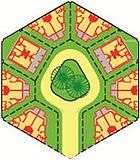 A small courtyard neighbourhood. |
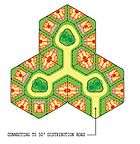 A cul-de-sac community composed from three connected courtyards. |
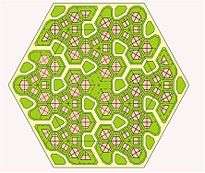 A honeycomb neighbourhood. |
It can also be described as a new form of cul-de-sac layout.
From Cul-de-sac to Honeycomb
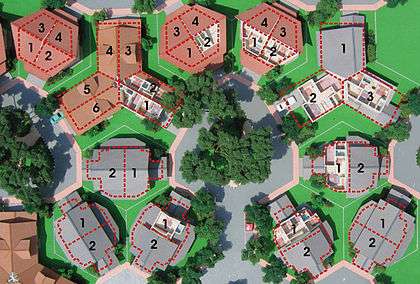
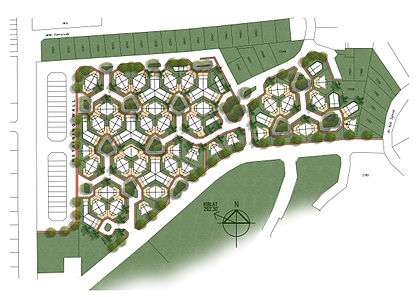
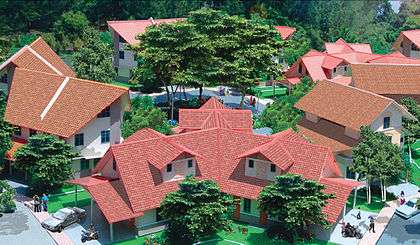
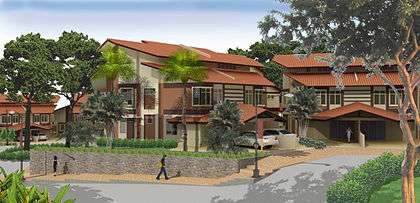
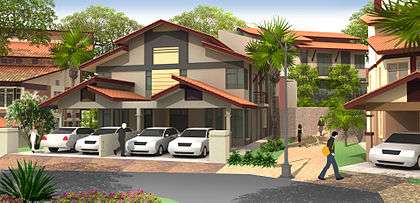
Cul-de-sacs are popular: they are perceived as being safer, more exclusive and neighbourly. According to one study, between the ‘grid’, ‘loops’ and cul-de-sacs, the latter were the most popular.[3] However, in developing countries like Malaysia, only the very rich can afford to live in quarter-acre single-family houses located in a cul-de-sac. The Honeycomb concept was a response to two questions:
• How can the cul-de-sac be made affordable for more people and for the environment?
• Is it possible to have cul-de-sacs without sprawl?
First, the cul-de-sac is made bigger so as to fit in a public green area in the middle in order to meet local planning regulations that require 10% of any residential development to be open space. Then an interlocking arrangement of cul-de-sacs is created such that each building lot would face two or three cul-de-sacs. If the buildings in this layout were detached houses, they would be priced in the top range of the market. But instead, the buildings are divided into 2, 3, 4 or 6, creating duplex, triplex, quadruplex or sextuplex units.
As the buildings are divided, the land area and the built-up area become smaller; the number of units in the layout and the density of the development go up to rival that obtained in terrace house developments. In this way, the housing units become less expensive. Yet each house still retains a public access. The size and shape of the external environment are not changed – only now more units share it[4]!
Since houses are built around a small park with plentiful shady trees, this communal garden is easily accessible to all in the cul-de-sac, allowing it to act as a social focus that can encourage social interaction and neighborly spirit.[5][6]
The courtyard area is a "defensible space" as well, as it acts naturally to reduce crime in the sense that strangers are quickly spotted. The short winding roads put a stop to speeding traffic, and certain to dissuade snatch thieves on motorcycles - therefore becoming safe for children, pedestrians and cyclists.[7]
Apart from the social advantages, it is also claimed that compared to the terrace house layout, the honeycomb layout uses land efficiently and offers savings in the cost of infrastructure.[8]
The honeycomb Layout may be said to be inspired from the geometrical design of Islamic tiles and the structure of beehives. Introduced by Kuala Lumpur-based architect Mazlin Ghazali, it has received a patent in Australia [9]
Honeycomb Housing projects under construction
The honeycomb concept has been applied to a hillside development on 14 acres of land at Kampung Nong Chik the edge of Johor Bahru business district in a development which advertises a modern version of the traditional village or "kampong" lifestyle.[10]
Criticism
Being so new, many developers would worry about the difficulty of obtaining approvals from the local authorities and so hesitate to be the first to adopt the honeycomb concept.[11] Another problem is that the houses are not rectangular and the house design ends up with odd corners in the house.[12] Another criticism comes from followers ‘fengshui’, the ancient Chinese art of geomancy, who believe that in a cul-de-sac ‘the chi energy coming to a house placed at the end of a road is usually fast, so the energy is pernicious and non-beneficial. Instead of bringing good fortune, it brings misfortune’.[13]
Nowadays cul-de-sacs are often frowned upon in planning circles,[14] especially by supporters of the New Urbanism: they do not permit higher densities, are car-dependent, and unlike grid systems, do not lend themselves to redevelopment and change. However the Honeycomb housing concept - which allows relatively high density - does appear to overcome some of the concerns here.[15]
References
- ↑ Mazlin Ghazali, Michael J. Durack, Mohd Peter Davis (2005), "Tessellation Planning and Honeycomb Housing", Planning Malaysia, Journal of the Malaysian Institute of Planners Vol. 3 pp.71-98 retrieved 25 September 2010
- ↑ "Project Highlight: Nong Chik Heights Johor Bahru", Building and Investment, Malaysia, April–May 2010 Issue, pp32-33
- ↑ Eran Ben-Joseph (1995), "Livability and Safety of Suburban Street Patterns: a Comparative Study", Working Paper 641, Berkeley, CA: University of California
- ↑ Treehugger.com website, Design and Architecture, "Reinventing the Cul-de-Sac", by Lloyd Alter,7 April 2008 Retrieved 25 September 2010
- ↑ New Straits Times, Malaysia, Property Times 4 June 2005 issue, "Building like a bee", by G. Umakanthan, 4 June 2005 Retrieved 25 September 2010
- ↑ Habsah Hashim, "Harmonious Community Living in Urban Neighbourhoods: A Case of Central Shah Alam", 8th. International Asian Planning Schools Association Congress, September, 2005; p18 Retrieved 25 September 2010
- ↑ Nikmatul Adha Nordin & Wan Rafyah Wan Muhd Zin, "Incorporating Children in Neighbourhood Design and Planning", International Asian Planning Schools Association Congress, September, 2005; pp9 Retrieved 25 September 2010
- ↑ Mazlin Ghazali, Mohd Peter Davis (December 2005), "Affordable Honeycomb Housing", Architecture Malaysia: Journal of the Malaysian Institute of Architects Volume 17 Issue 6 pp.36-40
- ↑ IP Australia, "A method of subdividing a plot of land for housing and a housing subdivision so formed", retrieved 25 September 2010
- ↑ George Lam (2009) , "HA: ideas and Concepts", Pace Publishing Limited, Hong Kong; pp 166-168
- ↑ Nikmatul Adha Nordin & Wan Rafyah Wan Muhd Zin, "Incorporating Children in Neighbourhood Design and Planning", International Asian Planning Schools Association Congress, September, 2005 Retrieved 25 September 2010
- ↑ The Edge, Malaysia, City & Country: "Good take-up for unsold stock", by Jacqui Chan, Monday, 26 October 2009 retrieved 25 September 2010
- ↑ World of Feng Shui website, "What To Do If You Live In A Cul-De-Sac", by Lillian Too retrieved 25 September 2010
- ↑ The Toronto Star, "End of the road for the cul-de-sac? Why planners and environmentalists are waging war on suburbia's lollipop developments" by Peter Gorrie, Sat 29 Mar 2008; retrieved 25 September 2010
- ↑ Treehugger.com website, Design and Architecture, "Reinventing the Cul-de-Sac", by Lloyd Alter,7 April 2008 retrieved 25 September 2010
Further reading
Mohd Peter Davis, Nor Azian Nordin, Mazlin Ghazali (2006), "Thermal comfort Honeycomb Housing", Universiti Putra Malaysia ISBN 983-3455-38-7